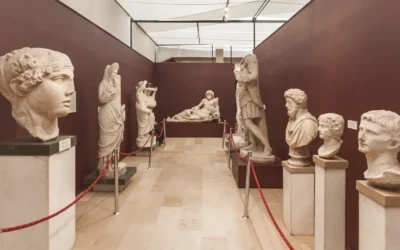You may be personally responsible for maintaining healthy conditions for your collections or beloved cultural heritage building, both as a result of your org chart and also your own personal sense of duty. But as the well-known saying goes…it takes a village to stay within temperature and humidity ranges. Let’s take a look at some of the people behind the scenes that may be surprising allies in your quest, and talk about how you can help them to help you. Your museum facilities engineers, your institutional leadership, and your front of house staff all have a role to play as you form a One Team mentality.
Working with museum facilities engineers
Chances are that you have one or more facilities engineers that are responsible for maintaining the environmental conditions in your building. I’ll name your engineers Aaron and Stefanie (she prefers Stef, by the way), so that I don’t have to call them “your engineers” for the rest of this post. Chances are also good that Aaron and Stef really do not know or care what it is that you are trying to protect, or what your institution’s mission is, or how innovative you are in the work that you do.
But it is crucial that we, as museum professionals, learn to speak their language,
talk with them about environmental challenges (maybe commiserate about the administration), and then work together with them to find solutions to your particular challenges.
Get technical with ASHRAE
Technical subjects that you should be familiar with could fill a whole second guide, but here are two tips to point you in the right direction. First, arm yourself with a basic understanding of the relationship between temperature and humidity. This is a fascinating subject all on its own, and a little time spent with Google can quickly get you caught up.
One very good source is the American Society for Heating, Refrigerating, and Air Conditioning Engineers.
ASHRAE publishes the standards that govern many organizations including OSHA, hospitals, and government agencies, and also has a whole set of recommendations for museums, galleries, libraries and archives. Your engineering team will be very impressed if you name-drop ASHRAE, by the way.
Learn about your HVAC system
Next, learn a little about your specific HVAC system. Is your building cooled by a series of package units? Is it a digitally controlled system with a central monitoring station?
Are you on a heating hot water loop that serves several buildings? How many air handlers are in use?
Asking Stef and Aaron about how your system works will do two things for you. First, you’ll learn a little something, and second, you will endear yourself to them because I guarantee they love to talk about their work!
These things are important to know because even though your museum facilities engineers are part wizard, they are still bound by the rules of thermodynamics and the limitations of your system. If you demand certain conditions be met, but haven’t taken the time to understand what you’re asking for, you may find that Stef and Aaron won’t be very accommodating to your requests.
Make the case to institutional leadership
Your institutional leadership is another very important part of your team. If your institution is housed within a larger organization like a university, you are likely to be considered a cost center for the university as opposed to a revenue driver.
Your very existence may be mandated by a charter somewhere, which means you get the bare minimum of support.
But do not fret, because if you employ a strategy of empathy and understanding, you may still be able to make progress.
The best way to build the One Team mentality with your admin is to understand their challenges, just as you did with the engineers. Similar to Aaron and Stef, the leadership may not know or care about your vision. Impassioned pleas to help further your mission are not likely to win arguments. However, if you begin to learn the language of the administrators, if you can understand how to make a business case for the HVAC upgrades or repairs that you need, you may very well get their attention and win their approval.
Check out the International Association of Museum Facilities Administrators
One organization that may be able to help you in this endeavor is the International Association of Museum Facilities Administrators. Although this organization requires paid membership, it’s an investment I’ve found to be very rewarding. It provides access to the expertise of museum professionals around the world who also have one foot in the operations and administrative functions of their institution.
Front of house staff bring qualitative data
Automated environmental monitoring systems provide crucial quantitative data, but
there is no better way to understand the actual experience of visiting your museum than to spend time with your front of house staff.
During my time at a university museum, I realized that I and most of the other curatorial or collections staff entered and exited the building through the side entrance, and would sometimes go a week or two without actually entering the museum’s spaces. This cut me off from critical qualitative data about the environment in the exhibition spaces.
You may have a PhD in your area of expertise, but the gallery guides, docents, security, and volunteers almost certainly have a better understanding of your physical environment in subtle but important ways.
Sometimes a room may feel too stuffy, or there may be evidence of pests hiding under a bench, or something just feels “off.”
Spend time with your front of house staff, and work to understand the challenges of their job. You will find that, just as with the facilities engineers and leadership, strong relationships in this area will not only broaden your awareness of your institution, but will also help you form allies in the fight to keep your collections well protected.
Get to know your allies
There is a common thread that ties together all three of these groups. Each faces unique challenges in their daily work, but each can contribute to your mission of top-notch collections care. The secret sauce is developing a One Team mentality by asking questions, getting to know who these potential allies are and the work they do, and then ultimately guiding those relationships into a strong sense of shared vision.
Nathan was an exhibitions designer and collections care professional in the private and museum sector, but now uses his facilities engineering skills to keep humans at the right temperature and humidity at a hospital in Tucson, Arizona. Hear more from him in the Conserv Community.
If you have any questions about environmental monitoring, integrated pest management, or just want to talk about preventative conservation, please reach out to us! Don’t forget to check out our blog or join our community of collections care professionals where you can discuss hot topics, connect with other conservators or even take a course to get familiar with the Conserv platform.





